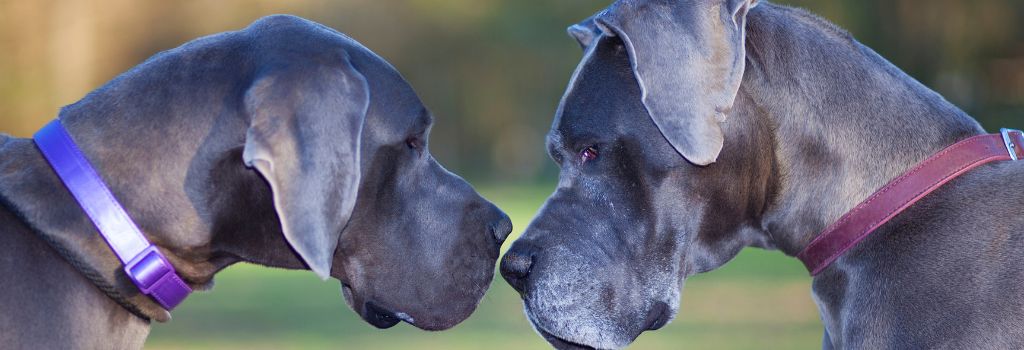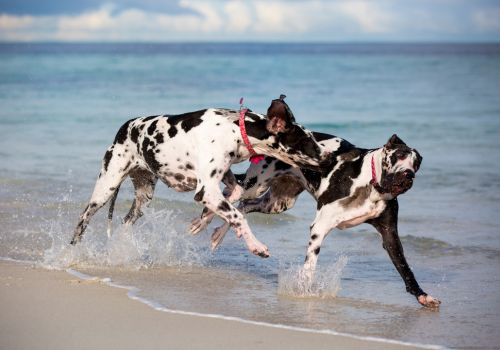Standing tall and magnificent, the Great Dane is a towering presence with a heart to match. Often referred to as a "Gentle Giant," this breed offers a unique blend of traits that make it a top pick for many families.
The Qualities That Melt Your Heart
So, why do so many people fall head over heels for Great Danes? For starters, these colossal canines are lovable, playful, and ever so friendly—qualities that turn heads and win hearts wherever they go. Whether you have kids or just need a furry BFF, Great Danes tick all the boxes.
Their steadiness and confidence make them excellent watchdogs. And, get this: they come with a built-in "intruder alert system," also known as a loud, resounding bark. So, don't let their mild-mannered demeanor fool you; when duty calls, they answer.
While they may be big, they’re agile, energetic, and brimming with athleticism, making playtime an absolute blast.
Quirks and Eccentricities We Adore
Okay, so they’re not perfect; but who is? If you're accustomed to smaller breeds, be prepared for a sizable change—Great Danes take up a lot of space. You might also notice that your Dane has a penchant for rowdy play, especially during their more youthful days.
Be prepared for some drool (or a lot of drool) and the occasional bout of flatulence. Hey, love is about accepting the whole package, right?
If left alone, your Great Dane might develop separation anxiety and take it out on your favorite shoes. Additionally, without proper socialization, they might display fearful or aggressive tendencies.

Why We're Smitten
Despite these quirks, their personality wins us over every time. With good socialization and training, Great Danes are truly "gentle giants." They’re courageous, loyal, and sometimes a bit reserved, but once they open up, their love knows no bounds.
A Peek Into Their Noble Past
Originally from Germany, Great Danes have a history that spans over 400 years. Once hunters of deer and boar and guardians of vast estates, they've traded those jobs for a more modern role: beloved family companion. A product of crossbreeding between the Irish Wolfhound and Old English Mastiff, the Great Dane—or "German Mastiff"—is an easy-going breed. They mature slowly, so take it easy on the exercise when they're young.
The Great Dane is not just a dog; it's an experience—an utterly charming, enormously affectionate experience. Sure, they have their idiosyncrasies, but that's what makes them unique and endlessly lovable.

Genetic Predispositions for Great Danes
Bloat: The Silent Emergency
Oh, the Great Dane! Majestic, towering, and at risk for a rather scary condition known as bloat, or Gastric Dilatation and Volvulus (GDV) in medical terms. Imagine your dog's stomach filling up with gas and twisting on itself like a balloon animal gone wrong. It’s as painful and dangerous as it sounds, cutting off blood supply and becoming fatal in as little as 30 minutes. Signs include restlessness, retching with no vomit, an enlarged abdomen, and sometimes a "prayer position" (front down, rear up). The good news? There's a preventive surgery that can help. But if you see these signs, rush to the nearest emergency hospital—every second counts.
Heart Disease: Listen to the Beat
Great Danes can be true gentle giants, but their hearts, unfortunately, aren't always as sturdy as their demeanor. Dilated cardiomyopathy (DCM) makes their hearts large, weak, and inefficient. Look out for fatigue, fainting spells, labored breathing, or coughing. Annual electrical heart screenings can be life-saving, and medications can manage the condition, so your Dane still has a chance for many tail-wagging years ahead.
Cancer: Catch It Early, Save a Life
Cancer is no joke, and Great Danes are more prone to some types. Look out for lumps, bumps, and behavioral changes. Specifically, Osteosarcoma (bone cancer) tends to target Danes, causing lameness and pain. Then there's lymphoma, a blood cancer that's usually treatable but costly. Hemangiosarcoma, a bleeding tumor usually found in the spleen, is often detected too late. But regular vet check-ups, including blood tests and ultrasounds, can offer early detection and better outcomes.
Bone and Joint Woes: Growing Pains and Beyond
Those long, gorgeous legs of your Great Dane can sometimes be the source of pain. Whether it's osteochondritis dissecans (OCD), where cartilage doesn't properly attach to the bone, or Panosteitis, an inflammatory condition, vigilant care is necessary. Early intervention can make a world of difference, whether it's medication for pain or surgery to correct a joint issue. Remember, overfeeding and rapid growth can exacerbate these problems, so stick to recommended diet plans.

Neurological Issues: Wobbly But Not Drunk
Ever seen your Dane wobble or stumble as if he had one too many? He could be suffering from Wobbler Disease, a condition that narrows the vertebrae in the neck and pinches the spinal cord. This disrupts the nerve signals to the brain, affecting your dog's stability. Various treatments ranging from medications and neck braces to surgery can help your dog lead a more stable life.
Eye Problems: More Than Meets the Eye
Your Dane's eyes are windows to his soul and also a potential area for health concerns. From inherited conditions to developed ones, many can lead to painful complications or even blindness. That's why eye evaluations are part and parcel of every vet checkup. Keep an eye out (pun intended) for any unusual symptoms, and don't hesitate to consult your vet.
Addison's Disease: When Hormones Take a Back Seat
You might have heard of Addison's Disease from medical dramas on TV, but did you know your Great Dane could be at risk too? This tricky illness is all about your dog's adrenal glands slacking on their hormone production duties, causing a haywire system that could be fatal if untreated. To make things more complex, its symptoms are so vague they often impersonate other conditions. But don't fret! A specialized blood test can accurately diagnose this problem. And guess what? We've got our eyes peeled for signs during every check-up, and will routinely check electrolyte levels just to be on the safe side.
Hemolytic Anemia and Thrombocytopenia: When the Blood Betrays
Imagine your Great Dane's immune system getting a little too enthusiastic and attacking his own red blood cells and platelets. Yikes, right? This could lead to anemia, making your Dane weak, lethargic, and pale in the gums. Or, it might result in abnormal bleeding and bruising if platelets are destroyed. To keep a handle on this, we’ll run clotting tests especially before any surgery, and medications like steroids can often keep this self-destructive behavior in check. In critical cases, a transfusion might be a lifesaver.

Thyroid Troubles: More than Skin-Deep
A seemingly minor hormone imbalance in your Great Dane can be the culprit behind various issues like dry skin, weight gain, or even behavioral changes. It’s called hypothyroidism, and it’s fairly common in Danes. Good news: an annual blood screening can catch this early, and it’s generally as easy to manage as giving your pup a daily pill.
Allergies: Itchy and Scratchy Show
If your Dane is licking his paws incessantly, has frequent ear infections, or is constantly rubbing his face, he might be dealing with allergies, or "atopy" to get technical. Unlike humans who sneeze and itch their eyes, a dog's skin gets itchy—often affecting their paws, ears, or belly. Thankfully, there's a bouquet of treatment options to make your dog less itchy and more comfy.
Mange: When Mites Overstay Their Welcome
Demodex mites: we all have them, even our dogs. But Great Danes sometimes struggle to keep these uninvited guests in check, leading to irritated, hairless patches on their skin. While some dogs grow out of it, others need ongoing treatment. Early veterinary intervention is the key to preventing this condition from getting out of paw—I mean, hand.
Paw Infections: No Walk in the Park
Ever seen your Great Dane limping or incessantly licking his paws? He could be dealing with pododermatitis, a painful skin infection between the toes. This condition seems to love dogs with allergies, so a check-up is in order if you notice any redness or inflammation. You wouldn’t want to walk on sore feet, and neither does your dog!
Dental Dilemmas: Not Just a Cosmetic Concern
Braces are not just for teenagers; even your Great Dane might need them! Dental abnormalities like malocclusion (a bad bite) or oligodontia (having too few teeth) are not just cosmetic issues. They can cause real problems for your Dane. But fear not! Whether it’s braces or tooth extractions, we can fix these issues before they affect your dog's "chew-tastic" life.
Don't have a vet in your area yet? We can help you find a local veterinarian.
If you have more questions the GeniusVets Telehealth platform will give you unlimited access to text and/or video calls with board-certified veterinarians! To learn more click here.


